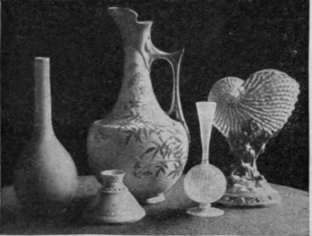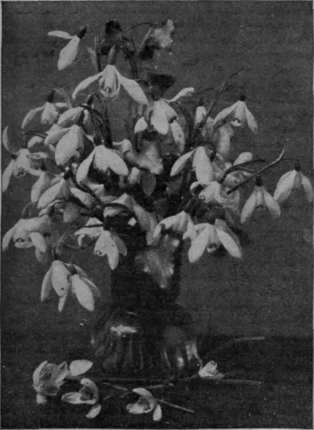The Preservation Of Cut Flowers
Description
This section is from "Every Woman's Encyclopaedia". Also available from Amazon: Every Woman's Encyclopaedia.
The Preservation Of Cut Flowers
When and How to Gather Flowers - Receptacles Suitable for Various Flowers - Floral "Aids " to Arranging Flowers - Flowers that Injure Other Flowers - Daffodil Poisoning - Some Useful Hints
Most people like to have some flowers in their rooms, and with a little knowledge as to their care and treatment it is possible to make cut flowers last a long time in water.
All flowers are best gathered in the early morning, particularly during the summer months. Never wait till mid-day, when the sun is hot.

Vases of certain forms or with narrow necks are difficult to clean, do not hold enough water, and are not suitable for cut flowers
For cutting flowers use a sharp knife in preference to scissors - the latter, unless very sharp, are apt to pinch the stems off, thereby closing up the pores or water passage. In the case of woody-stemmed plants, a slanting cut is desirable, as this provides a larger surface for the absorption of water.
Narcissus, violets, daffodils, lily of the valley, cyclamens, wood hyacinths, etc., should be pulled and not picked off, as if the hand is held low down one insures getting the full length of the stalk, which is so advantageous.
It is essential that all flowers should be placed in water as soon as cut. If there is not time to arrange them at once, put them in a large bowl, up to their necks in tepid water, and this will help greatly to prolong their life.
And here I would say a few words on the choice of suitable receptacles for flowers.
A simple form of vase is best, one easy to clean, since cleanliness is essential to the preservation of flowers.
If the stems of the vases are too slender their capacity for water is too small. The flower stalks, consequently, will be so tightly packed as to have no chance of survival, and the blooms will soon fade. Vases of trumpet shape should only be used for single specimens, or very thin-stalked flow
A vase with firm base and wide mouth is excellent, whether it be tall or short. Most flowers can be easily arranged in a vase of this nature without any aid at ail. and will always look well. It is especially suitable for daffodils and other bulbous plants.
An old cut beer-glass is ideal for violets, primroses, and snowdrops.
Floral "Aids"
Nothing looks better in a room than large bowls of flowers, a good effect being obtained by using the ordinary china fern-pots if no more elegant form of pottery is available.
A bowl looks charming for either long or short-stalked flowers. For the former, however, some sort of floral "aid" is necessarv, one of the very best being of glass perforated to hold the flower stalks. In glass bowls and all shallow vessels it is almost invisible. There are several "aids" to floral decoration, including the well-known narrow strip of twisted lead, and there is no doubt that these enable one to economise one's material. Another "aid" takes the form of a meshed-wire cover, which is made to fit over the tops of vases, but this is not to be recommended for every flower, as it does not keep down the stems.
For those who do not possess any floral "aids," I would suggest the following simple substitute, which is within the reach of all.
Take a piece of ordinary garden clay and press it firmly. This can then be placed at the bottom of any opaque vessel, and the flowers can be stuck into it. It is well to punch small

Suitable flower vases with wide mouths, so that the flowers bend outwards, and it is easy to get a mop in for cleaning purposes

Snowdrops arranged in soft water which is changed each day will keep fresh in a cool room for five days holes in it when dealing with soft, fleshy-stemmed flowers.
The water should not be poured into the bowls until the process of arranging is finished.
It is helpful to use an inner receptacle for the clay - an old tooth-powder tin answering the purpose very well. Earth can be used by those who cannot procure clay, but must be renewed from time to time, as it is apt to become sour. Clay, on the other hand, keeps perfectly good, and is excellent for flowers, since it acts as a preservative.
Many people consider the position of flowers in a room an unimportant detail, but taste and discretion are necessary in this respect.
A favourite position for vases of flowers is the mantelpiece. This is the very worst place in the room if there is a fire, for the heat soon withers the blooms. A draught is equally injurious.
It is a mistake also to place flowers by open windows, or where the sun falls directly upon them. Gas-lighted rooms, too, are particularly noxious for plants. It is advisable, therefore, to remove all vases from the warm sitting-rooms at night and set them in a cool place, or on a stone floor.
There are various methods of prolonging the life of flowers. One of the easiest and most important is that of changing the water every day. If stalks have become slimy, rinse them under the tap before putting the flowers back into the vases. It is also well to cut a small portion off the end of each stem, especially those of the woody type.
If possible, always use soft water, and warm water in preference to cold. Except in the case of certain ferns, it is always wise to strip stems. of their foliage to the point of immersion. This is especially necessary with wallflowers, stocks, and others of the cruciferae family, as the leaves quickly pollute the water and diffuse bad odours.
Poisonous Flowers
There are certain flowers which are recognised as poisonous to other blossoms; for instance, mignonette, poppy, ivy, forget-me-not, elder, sweetbriar, stock, lemon verbena, wallflower, mallow, and a few others. It is well, therefore, not to mix these with other flowers, or if one does so to use sparingly of the poisonous kind, and renew the water frequently. A thorough washing of the stems in warm water will greatly help to counteract the poisonous effects of these plants.
Of all spring flowers, the daffodil, of which there are endless varieties, is perhaps the favourite bloom for house decoration, for besides being very beautiful, it has the additional advantage of being inexpensive.
Those who grow their own daffodils should gather the. flowers when the bloom is quite young, as those which mature in water .are superior in purity and colouring to those left to expand in the open. It is well before arranging daffodils or narcissi, to stand them in water for an hour or two, and then cut the ends before placing in vases. The stems are full of a mucous matter, which, if the above precaution is not taken, quickly pollutes the water. In this connection, a word of warning should be given to those who pick daffodils to be careful that

Daffocis arranged with the aid of a piece of clay with holes in it they have no cuts or scratches on their hands, otherwise they are liable to get what is known as "daffodil poisoning."
Most of the workers in the flower fields at bunching time suffer from this complaint. Their hands are usually chapped with the wind, and the juice of the daffodil acts as an irritant on the skin. It is therefore advisable to wear gloves or else thoroughly grease the hands with tallow when engaged in picking this or similar plants.
Tulips are particularly useful as cut flowers on account of their wonderful vitality. The long-stemmed ones look especially graceful in vases, their only drawback being a tendency to hang their heads. This defect, however, can be easily remedied by immersing the whole length of the stems in lukewarm water.
Poinsettias are flowers which need special treatment when required for indoor decoration. The ends of the stems should be burnt as soon as cut, or else dipped into boiling water, otherwise the bracts quickly droop. The iris is likewise benefited by having the end of its stem charred.
Although long-stalked flowers are more effective as decoration, there is no doubt that short-stalked ones last longer. This is especially true as regards lilies and Lenten roses. The only satisfactory way of utilising the latter as a cut flower is to pick off each with its own short pedicel, split up the end of the stem, and arrange in big, open bowls.
Avery pretty flower for the table is primula obconica, its blossoms being white, mauve, and pale pink. Gloves must, however, be worn when handling this plant, as the hairy leaves and stalks, when touched, set up a severe irritation on the skin of the hands.
A charming effect is produced by using red geraniums arranged with maidenhair or asparagus fern on a white cloth. If this scheme of decoration is adopted, it is well worth while to take the following advice. Drop a spot of floral gum into the centre of each geranium pip, and this will prevent the petals falling, and the geraniums will last for nearly a week.
Maidenhair fern is one of the few plants which live longer when part of the frond is in water. It will last even better if taken out of the vase every day and plunged bodily into water for an hour or two.
When flowers are threatening to droop or become over-blown, and it is particularly necessary for them to last, it will be found an excellent plan to take them from their vases overnight, thoroughly sprinkle with water, and wrap them, stems, blossoms, and all, in a wet cloth. Put them aside in a cool place until morning, when the flowers will be found to be much fresher than if they had been left in their vases, and yet not overblown. To be continued.
Continue to:


